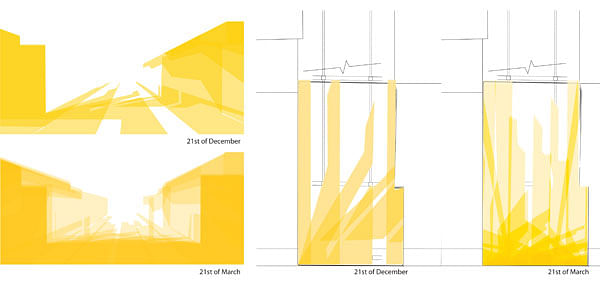
The competition asked for a design of a temporary exhibition structure/pavilion under the HighLine in New York City, able to offer 1200 Sq. feet (112 M2) of exhibitionstructure/installation and 2200 Sq. feet (204M2) of open gathering/sitting area. The structure had to be structurally independent.
Two key words, repetition and ensemble, describe the way the structure is lifted from the ground to come together with a simple and puzzle-likeconstruction. The idea of a design for a pavilion based on the variedrepetition of a piece aims to reduce production time by using laser cuttingtechniques and construction times by assembling the pieces delivered to thesite as a flat pack pavilion.
The design process started with one question: How to inhabit a forgotten and disused urban space?. Trying answering this question became a challenge and Sun light the design driver by which the space could be transformed into something of a unique piece.
Considering the flexibility and the temporal conditions of the space intended, the idea is to transform an object familiar to the place -a train wagon -, an object which belongs to the memory of the site, much in the way The Highline reminds us of its own past.
The site is then inhabited by two wagons. The first front section of each one offer the chance, at night, to artificially illuminate the entrance area, where visitors can gather (standing or seating) while enhancing the presence of the pavilion by transforming it into a street event, letting passers by know of its presence. Disable access is provided by means of a ramp leading up to the podium from which the visitor can access one of the wagons or get through to the interior central space where more seating (some of them sun-bathed at day peak times) is provided. Floors are all leveled once in interior central space, so visitors with reduced mobility can go in and out of the wagons with no difficulty. This way, the exhibition area is combined with the sitting/gathering area all in one reading. Openings for entrances and walls are incorporated in to the same language to allow for continuity of the surface.
Derived from the section of a freight train, this new “wooden wagon”, a remnant structure from the past, reacts to the travel of sunlight through the site. To allow for the light to dictate the organization of the space under The Highline, the wooden section:
- Opens, letting visitors in to enjoy the sun light (12.30pm to 2.30 pm in winter times),
- Closes (to allow more intimate areas and the use of artificial light, if exhibitions require so)
- Becomes continuous and discontinuous (to play with notions of interior-exterior under the overall interior space roofed by The Highline), thus forming different spaces and trajectory paths in which the pavilion can be understood and enjoyed.
Status: Competition Entry
Location: New York, NY, US
My Role: Architect
Additional Credits: Fellow team member: Arch. Lucy Querales



